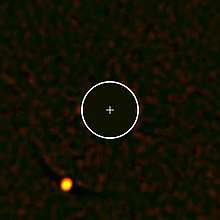HIP 65426 b
HIP 65426 b is a super Jupiter exoplanet orbiting the star HIP 65426. It was discovered on 6 July 2017 by the Max Planck Institute for Astronomy using the Spectro-Polarimetric High-Contrast Exoplanet Research (SPHERE) instrument belonging to the European Southern Observatory (ESO).[1][3] It is 385 light-years from Earth.[4] It is the first planet discovered by ESO's SPHERE instrument.[5]
 HIP 65426 b is on the lower left of the image, with the circle representing what Neptune's orbit would look like around the star HIP 65426, represented by a small cross. | |
| Discovery[1] | |
|---|---|
| Discovered by | Max Planck Institute for Astronomy[2] |
| Discovery date | 6 July 2017 |
Overview
The star HIP 65426 b is orbiting lies in the constellation Centaurus. It is around 14 million years old, and was expected to still have a debris disk. However, it doesn't have a debris disk, despite its young age,[3][4] causing it to not fit current models for planetary formation.[6] It is around 92 AU from its parent star, with a possible dusty atmosphere.[7] It was discovered as part of the SHINE program, which aimed to find planetary systems around 600 new stars.[8]
References
- "Scientists have found a planet that means everything they thought about planets isn't true". The Independent. 2017-07-08. Retrieved 2019-08-02.
- "Odd planetary system around fast-spinning star doesn't quite fit existing models of planet formation". www.mpia.de. Retrieved 2019-08-03.
- "Astronomers Directly Image Super-Jupiter around HIP 65426 | Astronomy | Sci-News.com". Breaking Science News | Sci-News.com. Retrieved 2019-08-02.
- NASA. "Holiday Special: Eight nights of Exoplanet Light". Exoplanet Exploration: Planets Beyond our Solar System. Retrieved 2019-08-03.
- information@eso.org. "ESO's SPHERE Unveils its First Exoplanet". www.eso.org. Retrieved 2019-08-15.
- "Odd planetary system around fast-spinning star doesn't quite fit existing models of planet formation". phys.org. Retrieved 2019-08-03.
- Wednesday, Mara Johnson-Groh | Published; July 12; 2017. "New exoplanet challenges formation models". Astronomy.com. Retrieved 2019-08-03.CS1 maint: numeric names: authors list (link)
- Chauvin, G.; Desidera, S.; Lagrange, A. -M.; Vigan, A.; Gratton, R.; Langlois, M.; Bonnefoy, M.; Beuzit, J. -L.; Feldt, M.; Mouillet, D.; Meyer, M.; Cheetham, A.; Biller, B.; Boccaletti, A.; d'Orazi, V.; Galicher, R.; Hagelberg, J.; Maire, A. -L.; Mesa, D.; Olofsson, J.; Samland, M.; Schmidt, T. O. B.; Sissa, E.; Bonavita, M.; Charnay, B.; Cudel, M.; Daemgen, S.; Delorme, P.; Janin-Potiron, P.; et al. (2017). "Discovery of a warm, dusty giant planet around HIP 65426". Astronomy and Astrophysics. 605: L9. arXiv:1707.01413. Bibcode:2017A&A...605L...9C. doi:10.1051/0004-6361/201731152.